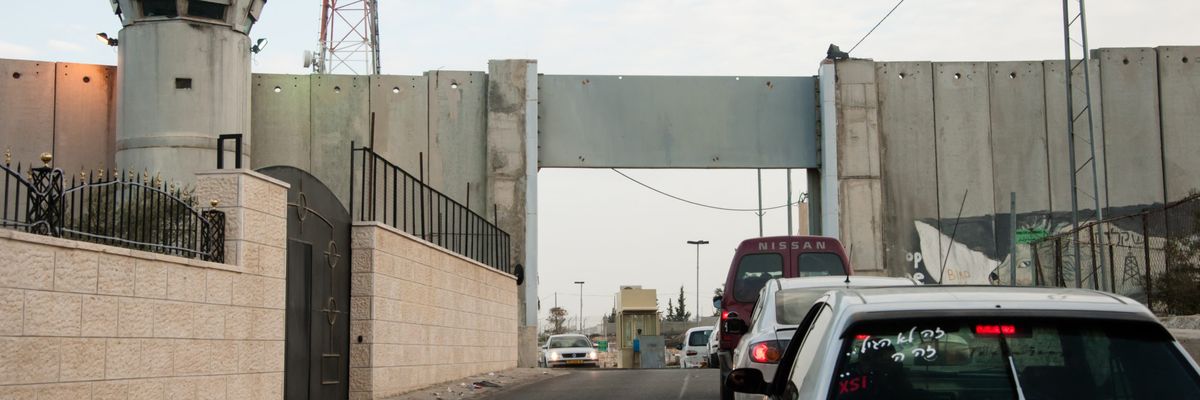The threat of COVID-19 in Israel/Palestine has created unprecedented cooperation between the Israeli and Palestinian authorities, including the Hamas-led government in the Gaza Strip, to limit travel.
Israel has a genuine interest in preventing the coronavirus from spreading among Palestinians, too. But the newly imposed travel restrictions serve an additional goal: furthering Israeli annexation of the West Bank, as outlined by the Trump administration’s Mideast peace plan.
In contrast to federal, state, and local governments in the U.S., the Israeli and Palestinian authorities began cooperating relatively early to contain COVID-19. They required travelers from at least some countries to self-quarantine in early February, they closed Palestinian schools on March 5 and Israeli schools on March 12, and as of last week, they mostly closed external borders and ordered residents of Israel and the West Bank to stay home.
Still, the number of confirmed cases in Israel reached 4,347 as of Monday afternoon, with 106 confirmed cases in the West Bank and nine confirmed cases in Gaza. Sixteen Israelis and one Palestinian have died of the virus so far.
No health system is prepared for this pandemic, but the Palestinian health system, weakened by decades of travel restrictions and economic de-development, is particularly vulnerable. That explains Palestinian cooperation with Israeli measures to prevent contact between Israelis and Palestinians, especially because at this stage, the virus appears to be more prevalent among Israelis.
On March 10, Israeli Defense Minister Naftali Bennet, leader of a pro-Israeli settlement political faction, issued an order banning Israelis from entering Area B, the 21 percent of the West Bank where most Palestinian villages are located. Israel and Hamas have closed the checkpoint between Gaza and Israel, except for some medical patients, and Israel closed the checkpoints that Palestinians use to cross into Israel.
Tens of thousands of Palestinian residents of East Jerusalem who live on the eastern side of Israel’s separation barrier are cut off from the rest of the city and its health services, despite formally having a right to those services. The checkpoints used by Israeli settlers to move between the West Bank and Israel remain open.
The restrictions deepen the separation of the two populations and further the annexation of Palestinian territory proposed by the Trump administration in January and embraced by Israeli leaders. The U.S. plan endorses formalizing the de facto regime in which Israel controls historic Palestine or the Biblical Land of Israel — the area between the Jordan River and the Mediterranean Sea where about 6.7 million Jews and 6.7 million Palestinians live — but grants full civil and political rights to Jews only.
It does so by proposing that Israel maintain control over the entire territory, including external borders, the airspace, and territorial waters, but relegate the 5 million Palestinians living in Gaza and the West Bank to enclaves or Bantustans euphemistically referred to as a Palestinian state. That plan would annex much of Area C, the 60 percent of the West Bank where most of the more than 600,000 Israeli settlers live, and keep Palestinians inside Areas A and B, the 40 percent of the West Bank where most Palestinian towns and cities are.
In other words, to implement the Trump plan, the parts of the West Bank where Palestinians live need to be severed from the areas where Israelis live or plan to live, and the Gaza Strip needs to be cut off. That is exactly what happened this month. The restrictions now in place — justifiable in the short term to contain COVID-19 — would, if maintained, bring the map of Israel/Palestine closer to the Trump plan’s conceptual map, including its recommendation to connect fragmented Palestinian enclaves to each other via tunnels, bridges, and walled bypass roads.
There is reason to question whether Israel will lift those restrictions, once the threat of COVID-19 diminishes. Throughout the history of the occupation of Gaza and the West Bank, Israel has initiated most of the legal and physical barriers that keep Palestinians out of so-called Israeli areas as “temporary” measures, often during emergencies, but never removed them.
With the 1991 outbreak of the First Gulf War, Israel reversed the open borders policy of the first two decades of the occupation by banning Palestinians from leaving Gaza or the West Bank without a permit. That prohibition remains in place 29 years later. The ban on Palestinians entering Israeli settlements in the West Bank, the ban on Israelis entering Palestinian cities in Area A, and the separation barrier that effectively annexes large swaths of the West Bank were all defended as temporary responses to the second Palestinian uprising of 2000, but they have become permanent. In each of the last 18 years, Israel has renewed a temporary 2002 measure banning Palestinian spouses of Israeli citizens from living in Israel.
Even now, at the cost of undermining efforts to contain COVID-19, Israel is continuing actions to remove Palestinians from the parts of the West Bank it claims for itself. Last Thursday, the Israeli military demolished and confiscated tents and structures intended for a field clinic to treat COVID-19 patients and emergency housing in the northern Jordan Valley — a part of the West Bank that the Trump administration wants Israel to annex.
That same day, Israel demolished additional structures in elsewhere in the Jordan Valley and near the northern West Bank town of Salfit, where one coronavirus case has been confirmed and hundreds are suspected, and the demolitions continue. Despite shelter-in-place orders, the Israeli army continues to allow Israeli settlers to take over Palestinian lands, including in areas like Bethlehem, which are under strict closure due to local virus outbreaks.
Unlike the Israeli occupation regime, COVID-19 doesn’t discriminate based on religion or ethnicity, so there are good reasons to keep people apart right now. But one day the virus will be contained. Only then will we know which of these “temporary” restrictions will actually be lifted, and how the map of Israel/Palestine will look then.















